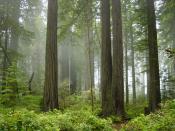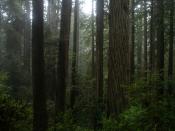Myers 8
California's Coastal Redwoods: Nature's Giants
Having dominated the northern hemisphere before the last ice age, California's coastal Redwoods (Sequoia Sempervirens) are now only found along a coastal strip of land stretching from Big Sur to just inside Oregon. They have survived drastic temperature changes and logging efforts and continue to amaze onlookers with their incredible size.
In 1996, a botanist and forest ecologist from Humbolt State University named Stephen "Steve" Sillett became the first person to ascend into the canopy of a Redwood. Since his first ascent, Sillett has climbed, measured, and studied hundreds of towering California Redwoods as well as their close relatives, Giant Sequoias (Sequoiadendron Giganteum). "[Climbing these trees] puts your own insignificant existence into perspective; makes you realize there is something much greater than yourself - so much vaster than you." (Sillett)
With the hope of finding out as much about these trees and their environment as possible, Sillett and his crew spent eight years studying a two acre plot of Redwood forest from roots to crown.
In this space, he discovered that there is more biomass in a Redwood forest than was ever recorded from tropical rainforest studies. In fact, he estimates that Redwoods contain roughly five to ten times more biomass than ever found during various tropical rainforest studies. The two acre plot yielded some astonishing and unexpected discoveries. Atop it's giant tree sized limbs which begin as much as two-hundred feet above the ground, Sillett and his team found a coating of soil known as "canopy soil" which was up to three feet thick in some places. Canopy soil is made from the rotting leaves of Redwood trees and fern roots and supports plants such as fruit bearing Huckleberry. Not only were the trees supporting their own simulated forest...


